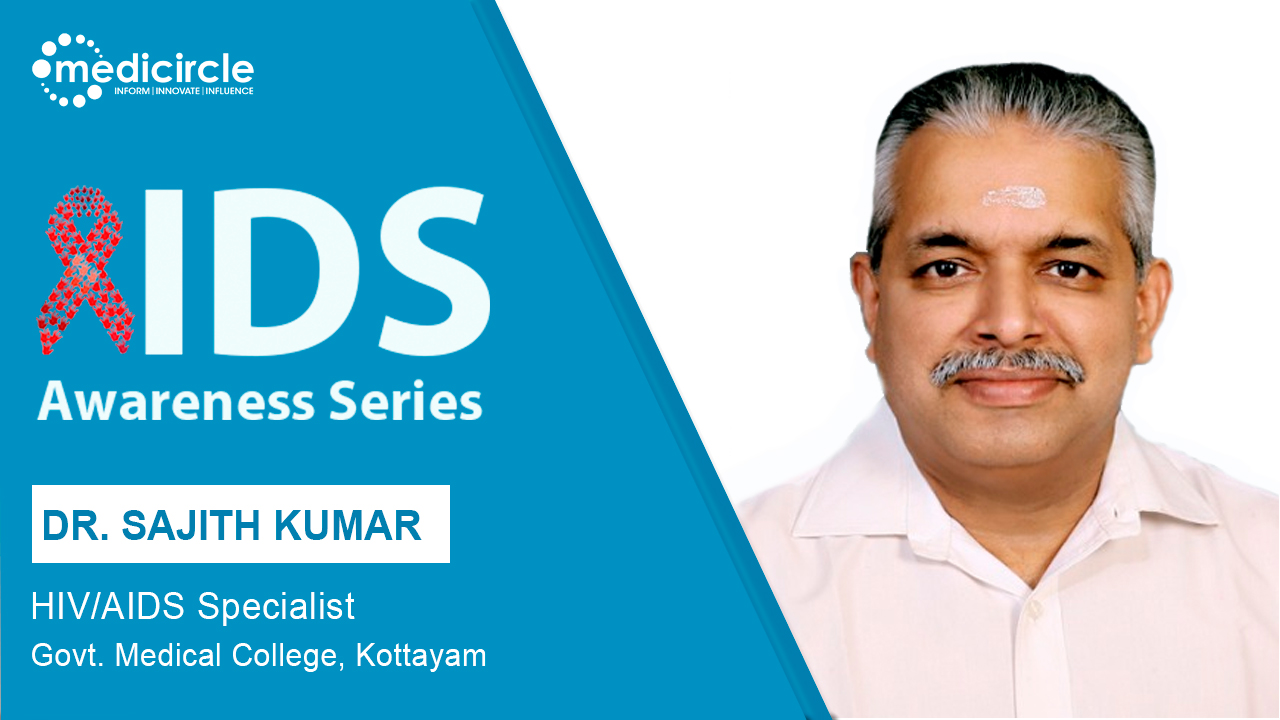Dr Sajith Kumar is one of the best doctors in Gandhinagar, Kottayam. He has been practising in this field for 34 years. He has completed his MD in General Medicine in 1987 from Government Medical College, Kottayam, Kerala and PhD in HIV / AIDS in 2005 from MG university, Kottayam, Kerala. Currently, He is a Professor of Infectious Disease in the Government Medical College Hospital in Kottayam, Kerala.
AIDS and its Causes
Dr Kumar begins, “AIDS was discovered in America in the 1980s, among men who were having sex with other men. So, it was identified that it was caused by a virus. This was named the human immunodeficiency virus (HIV). Once HIV enters your body it suppresses your immunity for a long stretch of time extending for years on end. Gradually the immunity would be diminished to an extent that the body will not be able to fight even the common diseases.”
“Bacteria, viruses and fungus who are unable to affect a normal body will be able to infect an HIV infected person. These are called opportunistic infections. When such illnesses are experienced by a person infected with HIV, we call it AIDS. AIDS is acquired immune deficiency syndrome.”
Coronavirus vs. Human immunodeficiency virus
Dr Kumar says, “The current world is not unaware of the word virus due to the coronavirus. But the major difference between Coronavirus and Human immunodeficiency virus is that the latter doesn’t kill immediately. HIV also doesn’t spread through the air or transfer through touch or contact.”
3 Routes of HIV transmission
Dr Kumar explains, “HIV is predominantly transported through 3 routes.”
“The first and the most important being the sexual route. This route was discovered right at the beginning when people were having sex, especially without protection. When people were having multiple partners or were having casual sex, the infection was being spread.”
“The second route of transmission is blood and body fluids. So if a person comes into contact with an HIV infected person’s blood and body fluid, then they can contract the virus. This particularly happens in the hospital environment due to the usage of needles. It is also seen in drug abuse where needles and syringes are shared.”
“The third way the virus gets transmitted is when HIV infected mothers become pregnant. One-thrid of such children can become positive with the infection.”
HIV variants
Dr Kumar mentions, “This disease has been with us for a while and we have gathered much knowledge about it. We know its different subtypes and its various variants. The most common variants are HIV-1 and HIV-2. The former leads to a serious disease whereas the latter leads to a milder disease. Some can get infected with both the variants.”
“The one differentiator of this virus is that it has a long duration of illness. After entering the body, the virus doesn’t produce an immediate result. It wouldn’t appear on the tests for a few weeks. We will be able to detect only in 6 weeks to 3 months of time. The virus stays in the body and destroys one's immunity within 10 years without any treatment. Some of them are asymptomatic. Since their illness cannot be identified, there is a high chance they will unknowingly spread the disease in society.”
“Isolation for such people for such a long duration is also not practical. Furthermore, it spreads due to sex, drug abuse and behavioural abnormalities. The younger generation is likely to indulge in such activities. This is why maximum HIV infected people get the infection between the age of 15 to 25. This virus has shown no boundaries and has affected the developed or underdeveloped and rich or poor societies alike.”
Protection against AIDS
Dr Kumar says, “The protection is tough as the virus gets contracted when no one is suspecting it. WIth physical relation or reusing needles, the virus can easily enter the body. The virus then enters the nucleus of your cell. From here, it is irreversible and the person will remain HIV positive for the rest of their life.”
“This infection mostly happen in youth who at that age are more willing to take risks and challenges. But they need to be very careful about this. Be very cautious and do not engage in sex with multiple partners. As even an HIV infected person appears asymptomatic. The second way of contracting the virus is through IV drugs which in itself is very dangerous. Sharing of the needles will expose you to not only HIV but also to hepatitis and other viruses.”
Prevention Tips
Dr Kumar mentions, “First thing to keep in mind is that a healthy individual, be it your friend or family, might be harbouring an infection without having an idea about it themselves. Once you know that infection can get transmitted from the person, make sure to avoid situations where it can spread. Don’t have unprotected sex with anyone even if they look completely healthy.”
“Go for safe sex or protected sex where there is a barrier. One can create a barrier by using a condom. Condoms have been with us for more than half a century. Earlier it was used to avoid contraception, but since the last 20-40 years it has been promoted to stop the spread of HIV infection. It is shown in countries like Thailand and women African countries, that significant use of condoms can really reduce the chance of HIV infection.”
“IV drug use is in itself a bad practice. Don't share the needles with anyone. Be in the habit of using disinfected needles or sterilised needles. But using certain drugs can also prevent contracting the virus. In certain unavoidable situations like sexual assault, such drugs are administered. The doctor can then recommend pre-exposure prophylaxis and post-exposure prophylaxis. With such steps and behavioural changes, one can prevent the risk of contracting the virus.”
Life expectancy of an HIV+ person
Dr Kumar elaborates, “When HIV started affecting the human population, there was nothing available to treat such patients. With low immunity, HIV infected people were prone to developing infections. The doctors then spent effort treating the infections. But from the 1990s, there were many drugs available with which the doctors can comfortably arrest the progression of HIV. An untreated person will go from the HIV stage to the AIDS stage in 10 to 15 years.”
“As of now every person who gets detected with HIV will be administered medicines. This could be 1 tablet per day and so on. In a few instances, there are many medicines combined into a single pill. India is supplying these antiretroviral drugs to the whole world and has saved the lives of millions.”
“With the right treatment, an HIV infected person can reach a normal lifespan. Patients who started these medicines in 1990 are still going strong despite 30 years. With regular medicines, the lifespan of the patient will be normal. The important thing here is to take the dose regularly. With these drugs, they are able to modify their lifestyle and behaviour and their lifespan too will be the same as a non-infected person."
(Edited by Priyal Shah)

 Know the major difference between the Coronavirus (COVID-19) and Human Immunodeficiency Virus (HIV). Furthermore, learn about the ways in which one can protect themselves from the slow and deadly virus that is HIV.
Know the major difference between the Coronavirus (COVID-19) and Human Immunodeficiency Virus (HIV). Furthermore, learn about the ways in which one can protect themselves from the slow and deadly virus that is HIV.




.jpeg)
.jpeg)
_(1).jpeg)
.jpeg)
_(1)_(1)_(1).jpeg)

.jpeg)

.jpeg)






.jpeg)

.jpeg)

.jpeg)

.jpeg)
.jpeg)



